A little history
The Ferrari 246 went through some of the best and worst times for the Scuderia. After a successful 1958 season, this single-seater rapidly turned into a dinosaur during a period of rapid changes.
The 246 model was designed by two of the greatest names in Formula One history: Carlo Chiti and Vittorio Jano. While the former drew the blueprints of the chassis, the latter, who had recently joined Ferrari after the Scuderia had taken over Lancia’s racing activities, was responsible for a radically new engine. Ferrari had been viscerally attached to V12 blocks up to then. Dino Ferrari, the Commendatore’s son, insisted on the development of a V6, a revolution at Maranello. Jano, to whom should be credited the world’s first production V6 (as the Lancia Aurelia’s engine) was obviously keen to give satisfaction to his employers, and designed a 1.5-litre block with a 65° “V” answering Formula Two rules. The original idea being credited to Dino Ferrari who had prematurely died in the meantime, the decision was taken to name “Dino” all non-V12 engines assembled in Maranello.
The success of this engine during the 1957 season prompted Ferrari to develop a Formula One variant, the Tipo 143, a DOHC engine enlarged to 2.4 litres. Fed on 100/130 AvGas, this engine was rated at 280 hp, and was developed on time for the opening of the 1958 season.
Seen for years as a simple curiosity, the rear-engined Cooper didn’t make anyone laugh anymore after winning the first two Grand Prix of the season. Caught off guard in Argentina, outclassed in the twisty streets of Monte-Carlo, the front-engined Formula One re-established their supremacy afterwards. The Vanwalls driven by Stirling Moss and Tony Brooks seemed to outclass the Ferraris. Fortune also played against Ferrari, which lost two of its pilots, Luigi Musso and Peter Collins, respectively killed during the ACF and German Grand Prix. Therefore the eventual success of Mike Hawthorn, who bagged only one win but proved extremely regular throughout the year, came almost as a surprise. Moss and Brooks totalled seven victories, which was well enough to give the very first title for manufacturers attributed in Formula One to their British employer.
For the next season, Ferrari’s workhorse in Formula One remained the 246, but re-engined with another of Jano’s creations, a 2.5-litre, 60° V6. The 2.4-litre, 65° engine’s career was far from over though, as it would be the very same engine that would later equip the road-going Dino 246. During 1959, the Coopers stood one step above the Ferraris, and no one could pretend to beat Jack Brabham for the title. The 246 still proved superior on very fast circuits, winning at Rheims and at the Avus, but the fact that the Scuderia was beaten on its very own Monza track, though itself anything but a slow circuit, was a peek at things to come during the following season.
Totally outshone in 1960, the 246 was easy game for the nimble Coopers and Lotuses. Wouldn’t it be for the cunning organizers of the Italian Grand Prix who bent the rules to advantage their beloved Scuderia, and in the process caused a massive boycott by the British teams, Ferrari wouldn’t have won even a single race. The machine’s obsolescence was acknowledged by the appearance of a new 246P, built around the same engine, but now placed at the rear à la Cooper, a first for Ferrari. Richie Ginther only raced a few times at the wheel of this car, which was never fully developed – Ferrari had better things to do, preferring to concentrate on the 1961 season for which it would unveil an effective weapon: the 156.
About the models
Model: Ferrari 246 - Dino
Year: 1958
Event: 1958 Formula One Championship (see below)
Maker: Ixo
Scale: 1/43
Distributed by: Fabbri as no.18 of its Ferrari Collection press series
Acquired: brand new, in November 2005, in Souillac, France
Despite the thick plastic wheels replacing the photo-etched metal ones used on genuine Ixos, this is a correct model worth 12/20.
Note: Fabbri doesn’t provide any indication regarding the event entered by this car. Pictures of Ferrari 246s during the 1958 season would help identifying this car - I have a few ones somewhere but didn’t take the time yet to look for them. Number 4 was used four times by the Scuderia during World Championship races that year: during the Dutch Grand Prix (Peter Collins, retired), the ACF Grand Prix (Mike Hawthorn, finished 1st, as die-cast makers like winners I’d bet this is the one), German Grand Prix (Wolfgang von Trips, finished 4th), and Moroccan Grand Prix (Phil Hill, finished 3rd)
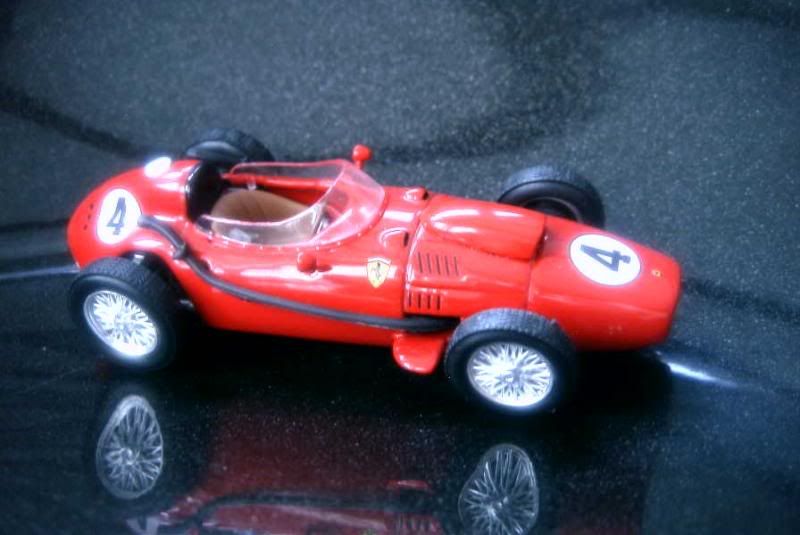
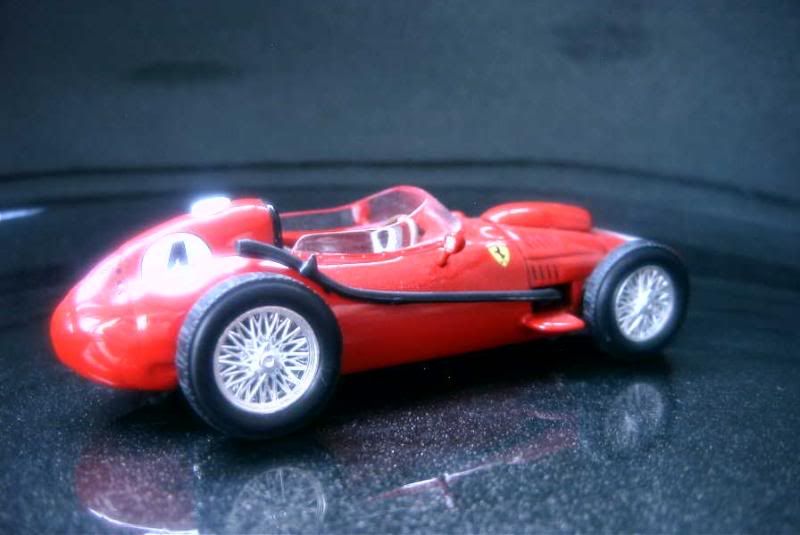
Model: Ferrari 246 - Dino
Year: 1958
Event: 1958 Italian Grand Prix (see below)
Maker: Brumm
Scale: 1/43
Distributed by: Brumm
Acquired: brand new, in March 2008, in Montpellier, France
Brumm’s main trait isn’t necessarily the quality of its models, but rather the originality of most models among its wide range. Furthermore the Italian seems to have made its specialty of reproducing very correct wire wheels in plastic. On the other hand, the cockpit is traditionnally poorly detailed. I’d give 11/20 to this model.
Note: This model is presented as having raced in the Italian Grand Prix, but no Ferrari was given number 1 during this event. In those times, the habit was to give only even numbers to Formula One cars, though there were exceptions. During that season, a lone Ferrari 246 received number 1 during a World Championship race: this was Peter Collins’ car at Silverstone for the British Grand Prix. Pictures of the original car are welcome in order to confirm this.
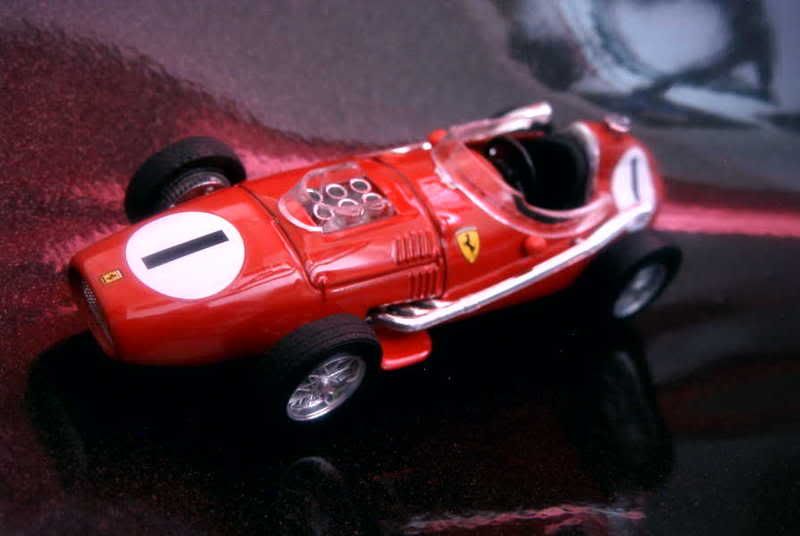
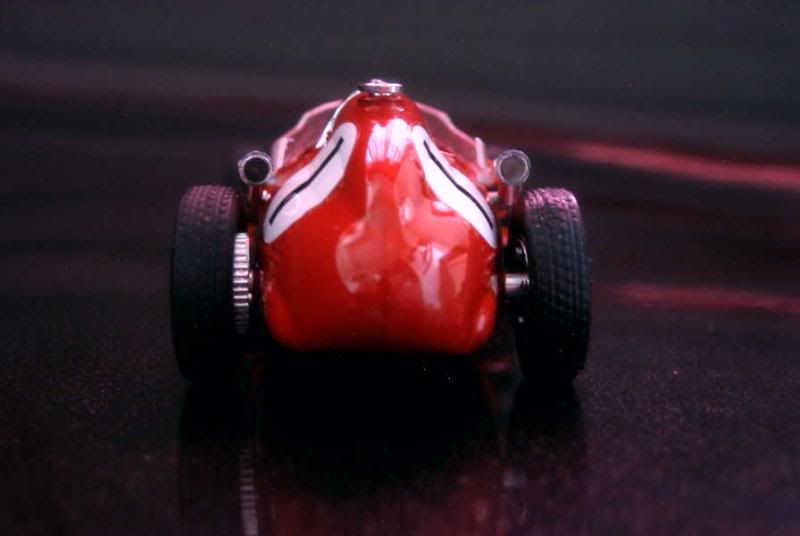
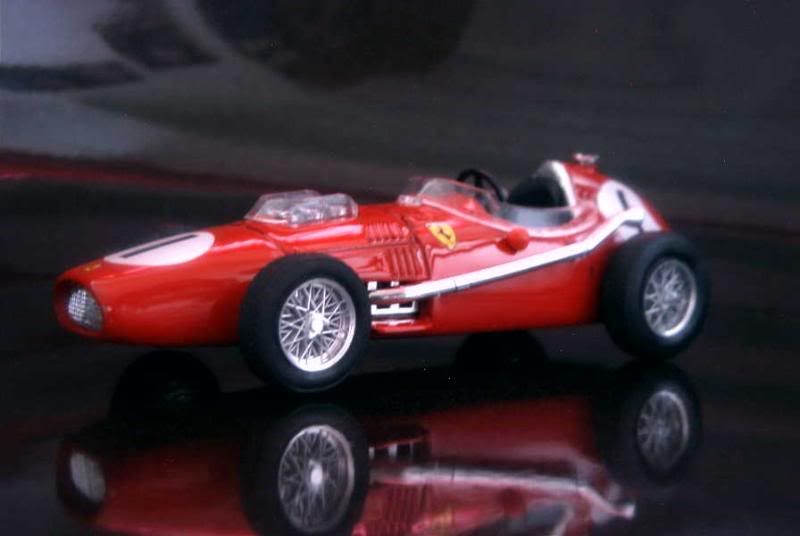
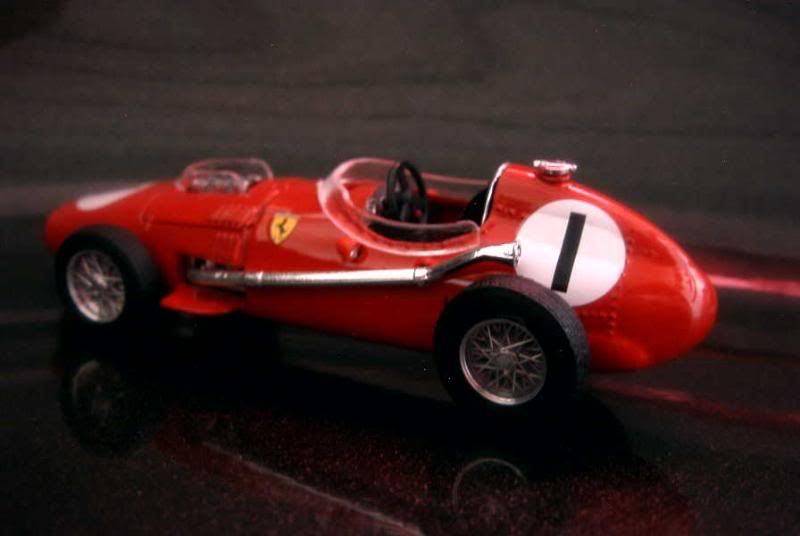
Model: Ferrari 246 - Dino
Year: 1959
Event: 1959 Monaco Grand Prix, driven by Tony Brooks (finished 2nd)
Maker: Ixo
Scale: 1/43
Distributed by: Ixo “Ferrari” series
Acquired: brand new, in May 2008, in Manila, Philippines
A very nice “short-nose” 246. The wire wheels are superb but take care of their spinners, which are all too often badly centered. My rating is 14/20.
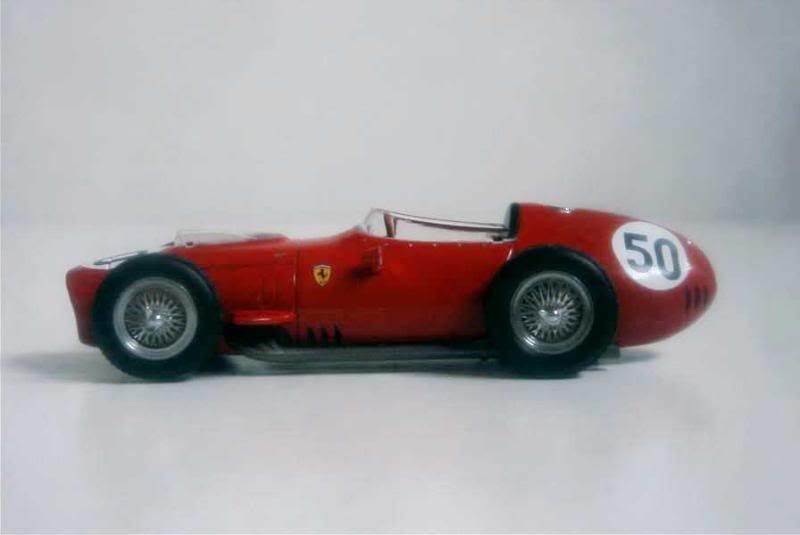

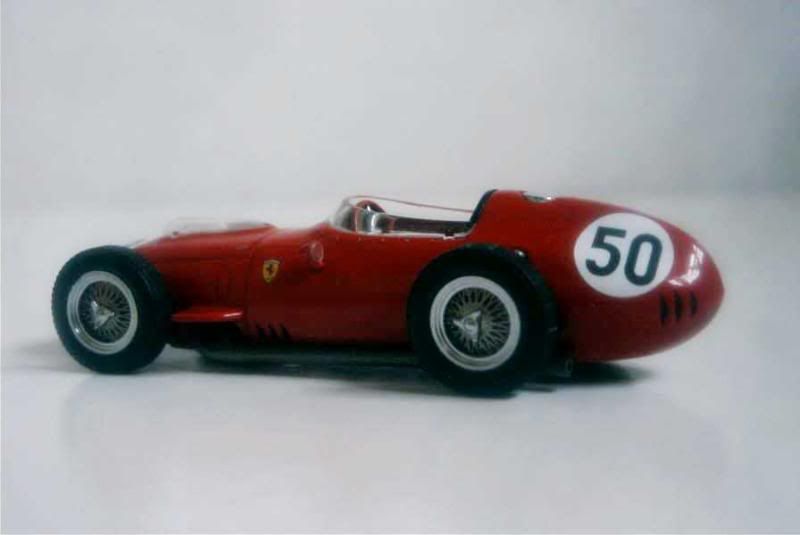
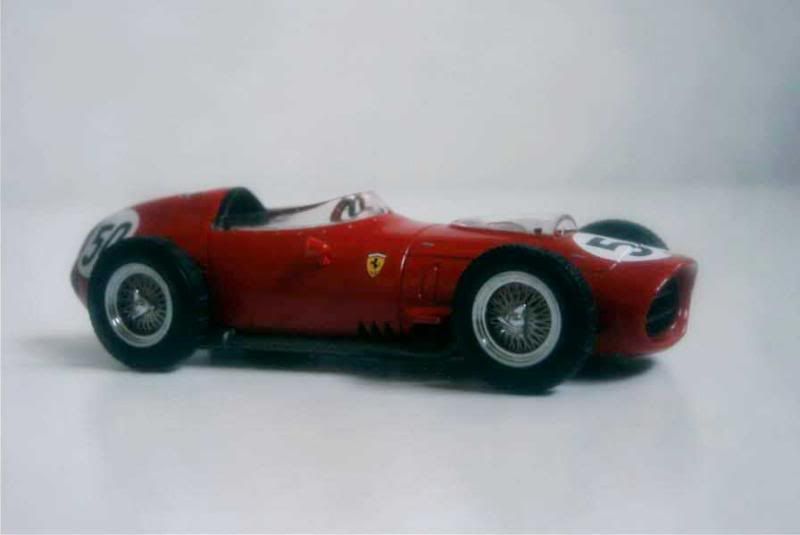
The Ferrari 246 went through some of the best and worst times for the Scuderia. After a successful 1958 season, this single-seater rapidly turned into a dinosaur during a period of rapid changes.
The 246 model was designed by two of the greatest names in Formula One history: Carlo Chiti and Vittorio Jano. While the former drew the blueprints of the chassis, the latter, who had recently joined Ferrari after the Scuderia had taken over Lancia’s racing activities, was responsible for a radically new engine. Ferrari had been viscerally attached to V12 blocks up to then. Dino Ferrari, the Commendatore’s son, insisted on the development of a V6, a revolution at Maranello. Jano, to whom should be credited the world’s first production V6 (as the Lancia Aurelia’s engine) was obviously keen to give satisfaction to his employers, and designed a 1.5-litre block with a 65° “V” answering Formula Two rules. The original idea being credited to Dino Ferrari who had prematurely died in the meantime, the decision was taken to name “Dino” all non-V12 engines assembled in Maranello.
The success of this engine during the 1957 season prompted Ferrari to develop a Formula One variant, the Tipo 143, a DOHC engine enlarged to 2.4 litres. Fed on 100/130 AvGas, this engine was rated at 280 hp, and was developed on time for the opening of the 1958 season.
Seen for years as a simple curiosity, the rear-engined Cooper didn’t make anyone laugh anymore after winning the first two Grand Prix of the season. Caught off guard in Argentina, outclassed in the twisty streets of Monte-Carlo, the front-engined Formula One re-established their supremacy afterwards. The Vanwalls driven by Stirling Moss and Tony Brooks seemed to outclass the Ferraris. Fortune also played against Ferrari, which lost two of its pilots, Luigi Musso and Peter Collins, respectively killed during the ACF and German Grand Prix. Therefore the eventual success of Mike Hawthorn, who bagged only one win but proved extremely regular throughout the year, came almost as a surprise. Moss and Brooks totalled seven victories, which was well enough to give the very first title for manufacturers attributed in Formula One to their British employer.
For the next season, Ferrari’s workhorse in Formula One remained the 246, but re-engined with another of Jano’s creations, a 2.5-litre, 60° V6. The 2.4-litre, 65° engine’s career was far from over though, as it would be the very same engine that would later equip the road-going Dino 246. During 1959, the Coopers stood one step above the Ferraris, and no one could pretend to beat Jack Brabham for the title. The 246 still proved superior on very fast circuits, winning at Rheims and at the Avus, but the fact that the Scuderia was beaten on its very own Monza track, though itself anything but a slow circuit, was a peek at things to come during the following season.
Totally outshone in 1960, the 246 was easy game for the nimble Coopers and Lotuses. Wouldn’t it be for the cunning organizers of the Italian Grand Prix who bent the rules to advantage their beloved Scuderia, and in the process caused a massive boycott by the British teams, Ferrari wouldn’t have won even a single race. The machine’s obsolescence was acknowledged by the appearance of a new 246P, built around the same engine, but now placed at the rear à la Cooper, a first for Ferrari. Richie Ginther only raced a few times at the wheel of this car, which was never fully developed – Ferrari had better things to do, preferring to concentrate on the 1961 season for which it would unveil an effective weapon: the 156.
About the models
Model: Ferrari 246 - Dino
Year: 1958
Event: 1958 Formula One Championship (see below)
Maker: Ixo
Scale: 1/43
Distributed by: Fabbri as no.18 of its Ferrari Collection press series
Acquired: brand new, in November 2005, in Souillac, France
Despite the thick plastic wheels replacing the photo-etched metal ones used on genuine Ixos, this is a correct model worth 12/20.
Note: Fabbri doesn’t provide any indication regarding the event entered by this car. Pictures of Ferrari 246s during the 1958 season would help identifying this car - I have a few ones somewhere but didn’t take the time yet to look for them. Number 4 was used four times by the Scuderia during World Championship races that year: during the Dutch Grand Prix (Peter Collins, retired), the ACF Grand Prix (Mike Hawthorn, finished 1st, as die-cast makers like winners I’d bet this is the one), German Grand Prix (Wolfgang von Trips, finished 4th), and Moroccan Grand Prix (Phil Hill, finished 3rd)


Model: Ferrari 246 - Dino
Year: 1958
Event: 1958 Italian Grand Prix (see below)
Maker: Brumm
Scale: 1/43
Distributed by: Brumm
Acquired: brand new, in March 2008, in Montpellier, France
Brumm’s main trait isn’t necessarily the quality of its models, but rather the originality of most models among its wide range. Furthermore the Italian seems to have made its specialty of reproducing very correct wire wheels in plastic. On the other hand, the cockpit is traditionnally poorly detailed. I’d give 11/20 to this model.
Note: This model is presented as having raced in the Italian Grand Prix, but no Ferrari was given number 1 during this event. In those times, the habit was to give only even numbers to Formula One cars, though there were exceptions. During that season, a lone Ferrari 246 received number 1 during a World Championship race: this was Peter Collins’ car at Silverstone for the British Grand Prix. Pictures of the original car are welcome in order to confirm this.




Model: Ferrari 246 - Dino
Year: 1959
Event: 1959 Monaco Grand Prix, driven by Tony Brooks (finished 2nd)
Maker: Ixo
Scale: 1/43
Distributed by: Ixo “Ferrari” series
Acquired: brand new, in May 2008, in Manila, Philippines
A very nice “short-nose” 246. The wire wheels are superb but take care of their spinners, which are all too often badly centered. My rating is 14/20.







6 comments:
Beautiful models!!!
Hello!
I was visiting your blog! It's very nice! I'm a 1:43 collector and I'll link your blog to my blog ok.
Best regards
Pgav
@interdomin:
Thank you and welcome back!
@PGAV:
Thanks a lot for your visit and for the link. Return any time you want, you're very much welcome here. I had a look at your three blogs, they're all excellent!
Great vintage Italian racers sir Laurent! Love them!!
Happy to see you back here Mike, and many thanks for your comments!
Post a Comment